Research Portfolio: Leadership, Training & Talent Management in NHS
VerifiedAdded on 2023/01/19
|9
|2935
|79
Report
AI Summary
This report provides an in-depth analysis of leadership, training, and talent management within the National Health Service (NHS). It explores theoretical models, such as Fayol's principles of management and the 5 B's talent model, and examines the role of HR in supporting management functions. The report identifies internal factors like communication and organizational environment, and external factors such as economic conditions and market competition, which impact leadership, management, training, and talent development within the NHS. Recommendations are offered to enhance HR practices, leverage technology, and improve training programs. The study emphasizes the importance of talent management in acquiring and retaining skilled employees, addressing challenges, and fostering organizational growth within the NHS.
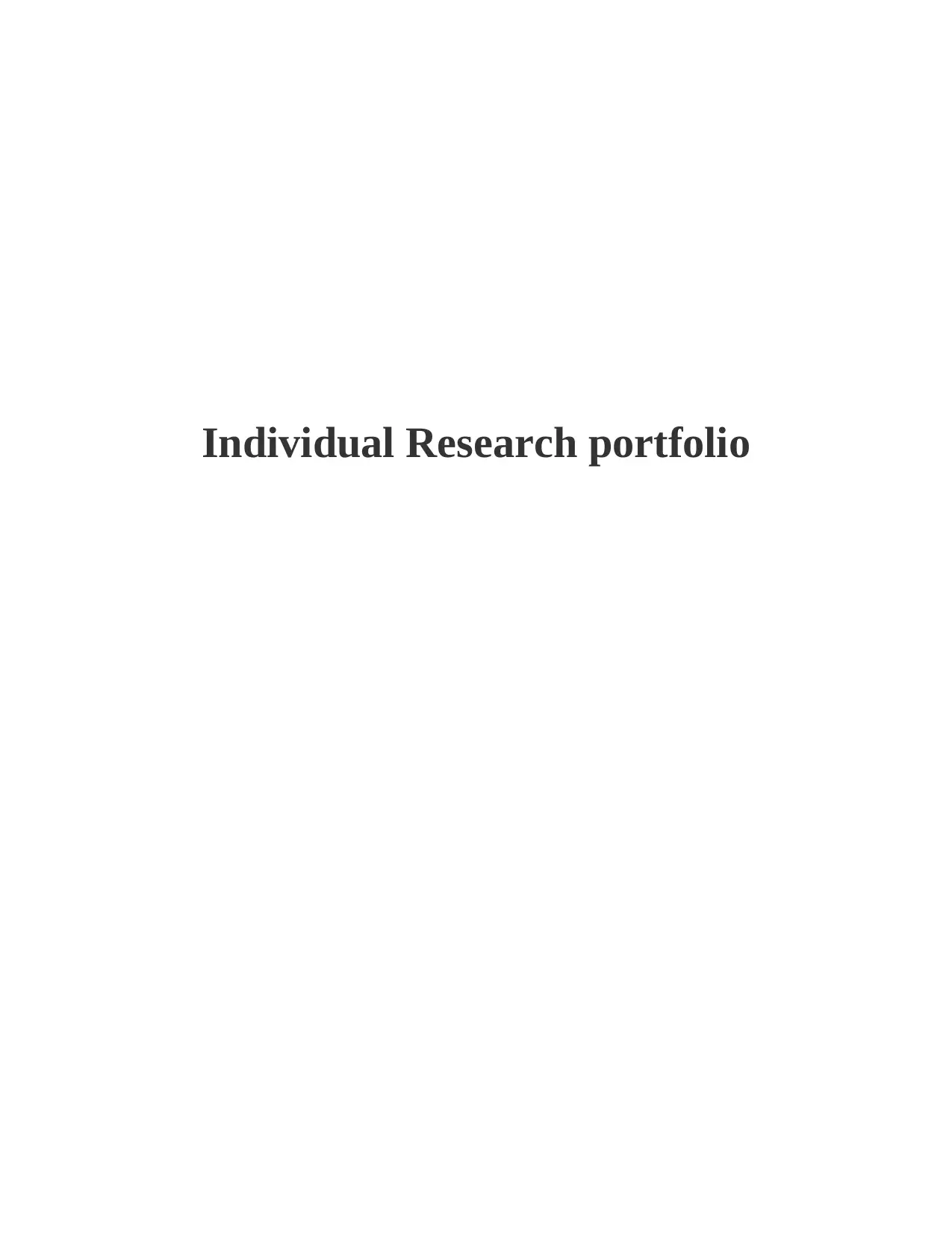
Individual Research portfolio
Paraphrase This Document
Need a fresh take? Get an instant paraphrase of this document with our AI Paraphraser
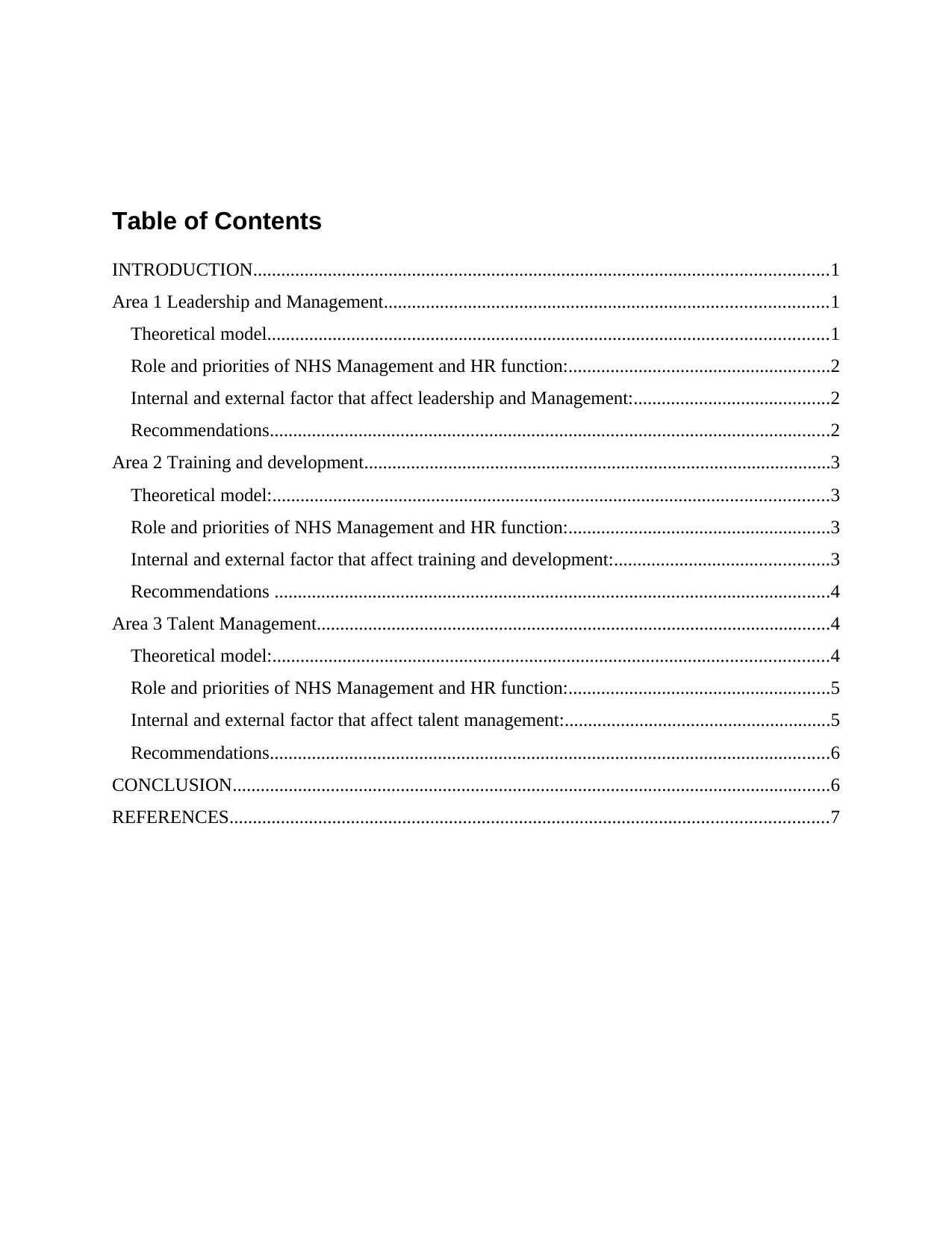
Table of Contents
INTRODUCTION...........................................................................................................................1
Area 1 Leadership and Management...............................................................................................1
Theoretical model........................................................................................................................1
Role and priorities of NHS Management and HR function:........................................................2
Internal and external factor that affect leadership and Management:..........................................2
Recommendations........................................................................................................................2
Area 2 Training and development....................................................................................................3
Theoretical model:.......................................................................................................................3
Role and priorities of NHS Management and HR function:........................................................3
Internal and external factor that affect training and development:..............................................3
Recommendations .......................................................................................................................4
Area 3 Talent Management..............................................................................................................4
Theoretical model:.......................................................................................................................4
Role and priorities of NHS Management and HR function:........................................................5
Internal and external factor that affect talent management:.........................................................5
Recommendations........................................................................................................................6
CONCLUSION................................................................................................................................6
REFERENCES................................................................................................................................7
INTRODUCTION...........................................................................................................................1
Area 1 Leadership and Management...............................................................................................1
Theoretical model........................................................................................................................1
Role and priorities of NHS Management and HR function:........................................................2
Internal and external factor that affect leadership and Management:..........................................2
Recommendations........................................................................................................................2
Area 2 Training and development....................................................................................................3
Theoretical model:.......................................................................................................................3
Role and priorities of NHS Management and HR function:........................................................3
Internal and external factor that affect training and development:..............................................3
Recommendations .......................................................................................................................4
Area 3 Talent Management..............................................................................................................4
Theoretical model:.......................................................................................................................4
Role and priorities of NHS Management and HR function:........................................................5
Internal and external factor that affect talent management:.........................................................5
Recommendations........................................................................................................................6
CONCLUSION................................................................................................................................6
REFERENCES................................................................................................................................7
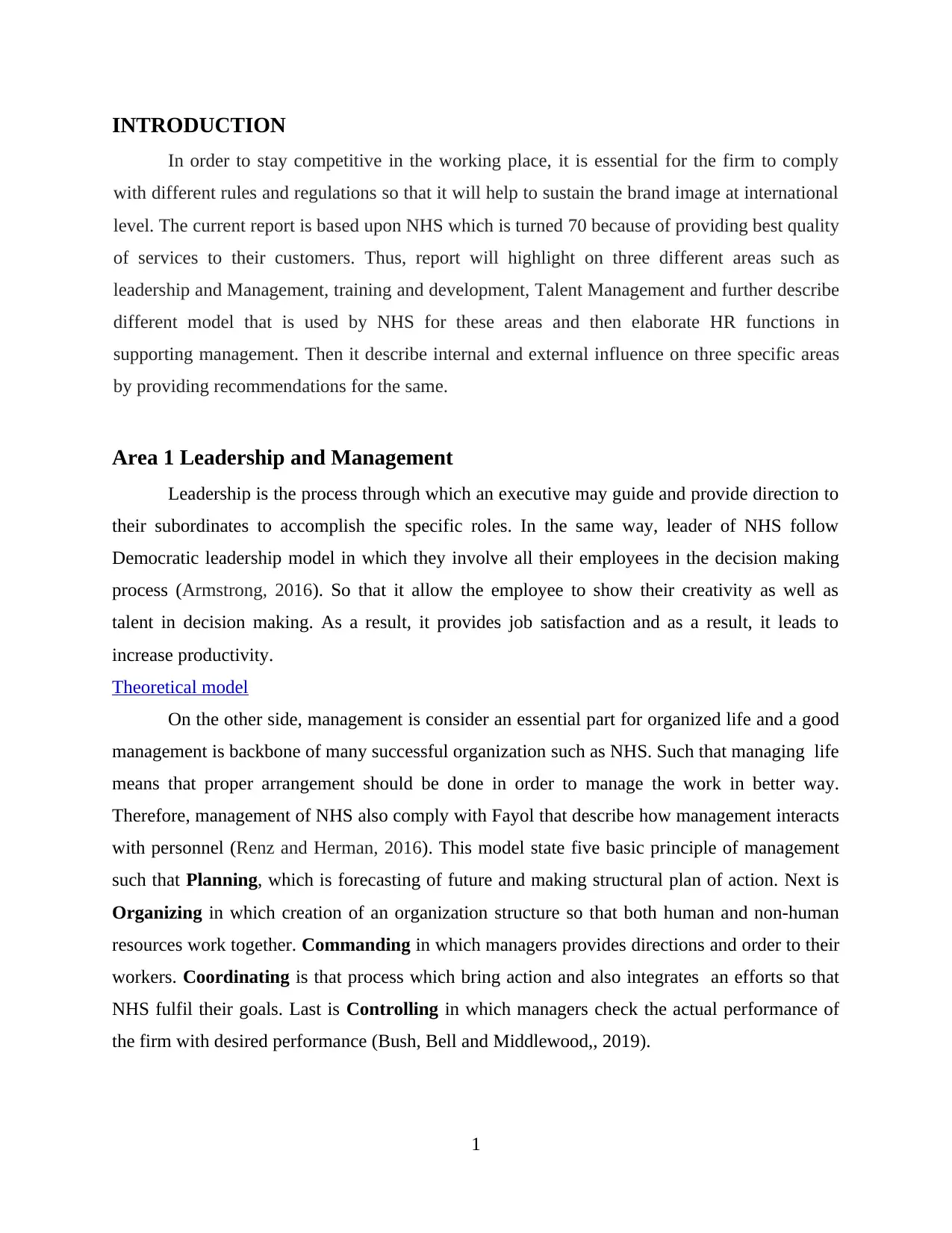
INTRODUCTION
In order to stay competitive in the working place, it is essential for the firm to comply
with different rules and regulations so that it will help to sustain the brand image at international
level. The current report is based upon NHS which is turned 70 because of providing best quality
of services to their customers. Thus, report will highlight on three different areas such as
leadership and Management, training and development, Talent Management and further describe
different model that is used by NHS for these areas and then elaborate HR functions in
supporting management. Then it describe internal and external influence on three specific areas
by providing recommendations for the same.
Area 1 Leadership and Management
Leadership is the process through which an executive may guide and provide direction to
their subordinates to accomplish the specific roles. In the same way, leader of NHS follow
Democratic leadership model in which they involve all their employees in the decision making
process (Armstrong, 2016). So that it allow the employee to show their creativity as well as
talent in decision making. As a result, it provides job satisfaction and as a result, it leads to
increase productivity.
Theoretical model
On the other side, management is consider an essential part for organized life and a good
management is backbone of many successful organization such as NHS. Such that managing life
means that proper arrangement should be done in order to manage the work in better way.
Therefore, management of NHS also comply with Fayol that describe how management interacts
with personnel (Renz and Herman, 2016). This model state five basic principle of management
such that Planning, which is forecasting of future and making structural plan of action. Next is
Organizing in which creation of an organization structure so that both human and non-human
resources work together. Commanding in which managers provides directions and order to their
workers. Coordinating is that process which bring action and also integrates an efforts so that
NHS fulfil their goals. Last is Controlling in which managers check the actual performance of
the firm with desired performance (Bush, Bell and Middlewood,, 2019).
1
In order to stay competitive in the working place, it is essential for the firm to comply
with different rules and regulations so that it will help to sustain the brand image at international
level. The current report is based upon NHS which is turned 70 because of providing best quality
of services to their customers. Thus, report will highlight on three different areas such as
leadership and Management, training and development, Talent Management and further describe
different model that is used by NHS for these areas and then elaborate HR functions in
supporting management. Then it describe internal and external influence on three specific areas
by providing recommendations for the same.
Area 1 Leadership and Management
Leadership is the process through which an executive may guide and provide direction to
their subordinates to accomplish the specific roles. In the same way, leader of NHS follow
Democratic leadership model in which they involve all their employees in the decision making
process (Armstrong, 2016). So that it allow the employee to show their creativity as well as
talent in decision making. As a result, it provides job satisfaction and as a result, it leads to
increase productivity.
Theoretical model
On the other side, management is consider an essential part for organized life and a good
management is backbone of many successful organization such as NHS. Such that managing life
means that proper arrangement should be done in order to manage the work in better way.
Therefore, management of NHS also comply with Fayol that describe how management interacts
with personnel (Renz and Herman, 2016). This model state five basic principle of management
such that Planning, which is forecasting of future and making structural plan of action. Next is
Organizing in which creation of an organization structure so that both human and non-human
resources work together. Commanding in which managers provides directions and order to their
workers. Coordinating is that process which bring action and also integrates an efforts so that
NHS fulfil their goals. Last is Controlling in which managers check the actual performance of
the firm with desired performance (Bush, Bell and Middlewood,, 2019).
1
⊘ This is a preview!⊘
Do you want full access?
Subscribe today to unlock all pages.

Trusted by 1+ million students worldwide
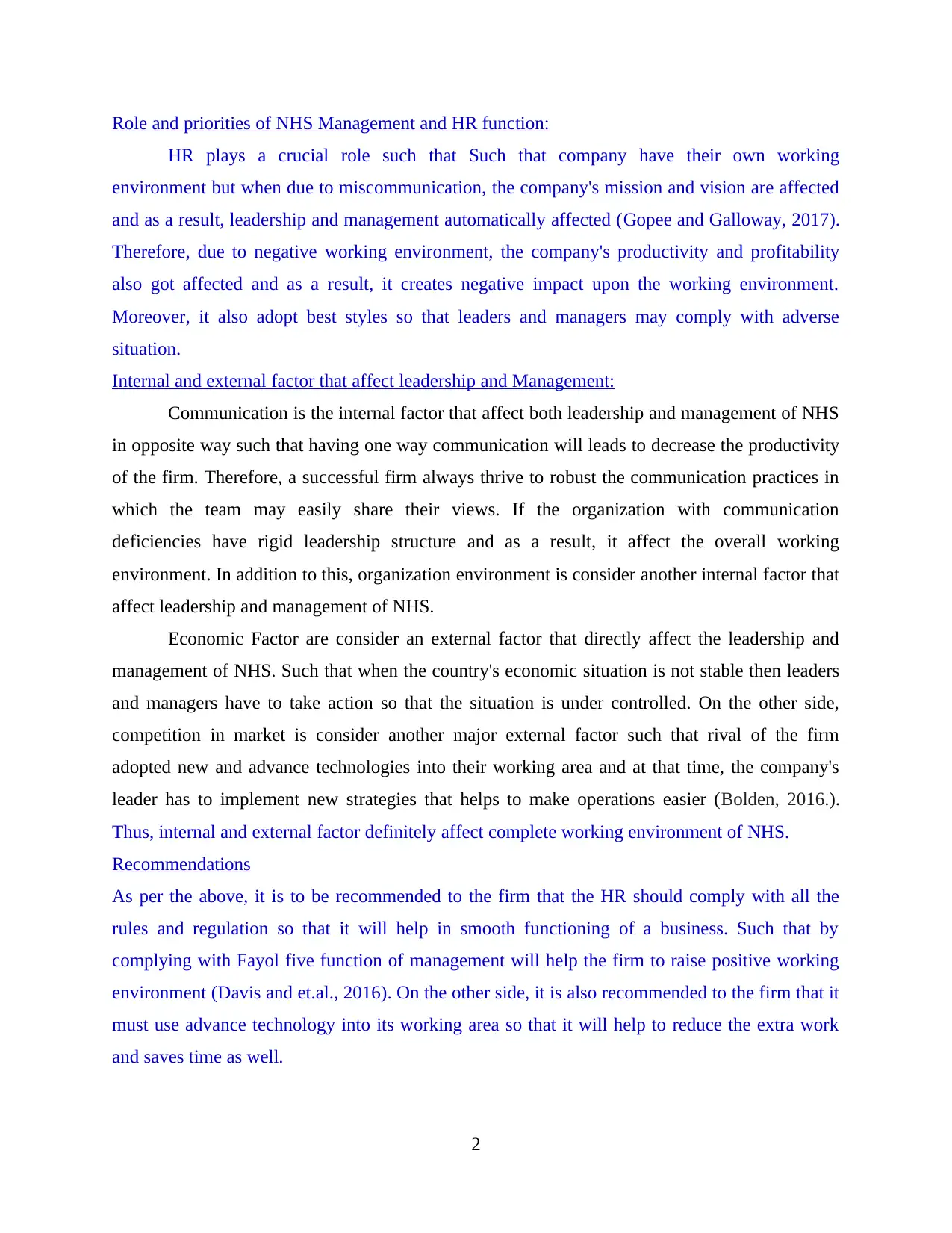
Role and priorities of NHS Management and HR function:
HR plays a crucial role such that Such that company have their own working
environment but when due to miscommunication, the company's mission and vision are affected
and as a result, leadership and management automatically affected (Gopee and Galloway, 2017).
Therefore, due to negative working environment, the company's productivity and profitability
also got affected and as a result, it creates negative impact upon the working environment.
Moreover, it also adopt best styles so that leaders and managers may comply with adverse
situation.
Internal and external factor that affect leadership and Management:
Communication is the internal factor that affect both leadership and management of NHS
in opposite way such that having one way communication will leads to decrease the productivity
of the firm. Therefore, a successful firm always thrive to robust the communication practices in
which the team may easily share their views. If the organization with communication
deficiencies have rigid leadership structure and as a result, it affect the overall working
environment. In addition to this, organization environment is consider another internal factor that
affect leadership and management of NHS.
Economic Factor are consider an external factor that directly affect the leadership and
management of NHS. Such that when the country's economic situation is not stable then leaders
and managers have to take action so that the situation is under controlled. On the other side,
competition in market is consider another major external factor such that rival of the firm
adopted new and advance technologies into their working area and at that time, the company's
leader has to implement new strategies that helps to make operations easier (Bolden, 2016.).
Thus, internal and external factor definitely affect complete working environment of NHS.
Recommendations
As per the above, it is to be recommended to the firm that the HR should comply with all the
rules and regulation so that it will help in smooth functioning of a business. Such that by
complying with Fayol five function of management will help the firm to raise positive working
environment (Davis and et.al., 2016). On the other side, it is also recommended to the firm that it
must use advance technology into its working area so that it will help to reduce the extra work
and saves time as well.
2
HR plays a crucial role such that Such that company have their own working
environment but when due to miscommunication, the company's mission and vision are affected
and as a result, leadership and management automatically affected (Gopee and Galloway, 2017).
Therefore, due to negative working environment, the company's productivity and profitability
also got affected and as a result, it creates negative impact upon the working environment.
Moreover, it also adopt best styles so that leaders and managers may comply with adverse
situation.
Internal and external factor that affect leadership and Management:
Communication is the internal factor that affect both leadership and management of NHS
in opposite way such that having one way communication will leads to decrease the productivity
of the firm. Therefore, a successful firm always thrive to robust the communication practices in
which the team may easily share their views. If the organization with communication
deficiencies have rigid leadership structure and as a result, it affect the overall working
environment. In addition to this, organization environment is consider another internal factor that
affect leadership and management of NHS.
Economic Factor are consider an external factor that directly affect the leadership and
management of NHS. Such that when the country's economic situation is not stable then leaders
and managers have to take action so that the situation is under controlled. On the other side,
competition in market is consider another major external factor such that rival of the firm
adopted new and advance technologies into their working area and at that time, the company's
leader has to implement new strategies that helps to make operations easier (Bolden, 2016.).
Thus, internal and external factor definitely affect complete working environment of NHS.
Recommendations
As per the above, it is to be recommended to the firm that the HR should comply with all the
rules and regulation so that it will help in smooth functioning of a business. Such that by
complying with Fayol five function of management will help the firm to raise positive working
environment (Davis and et.al., 2016). On the other side, it is also recommended to the firm that it
must use advance technology into its working area so that it will help to reduce the extra work
and saves time as well.
2
Paraphrase This Document
Need a fresh take? Get an instant paraphrase of this document with our AI Paraphraser
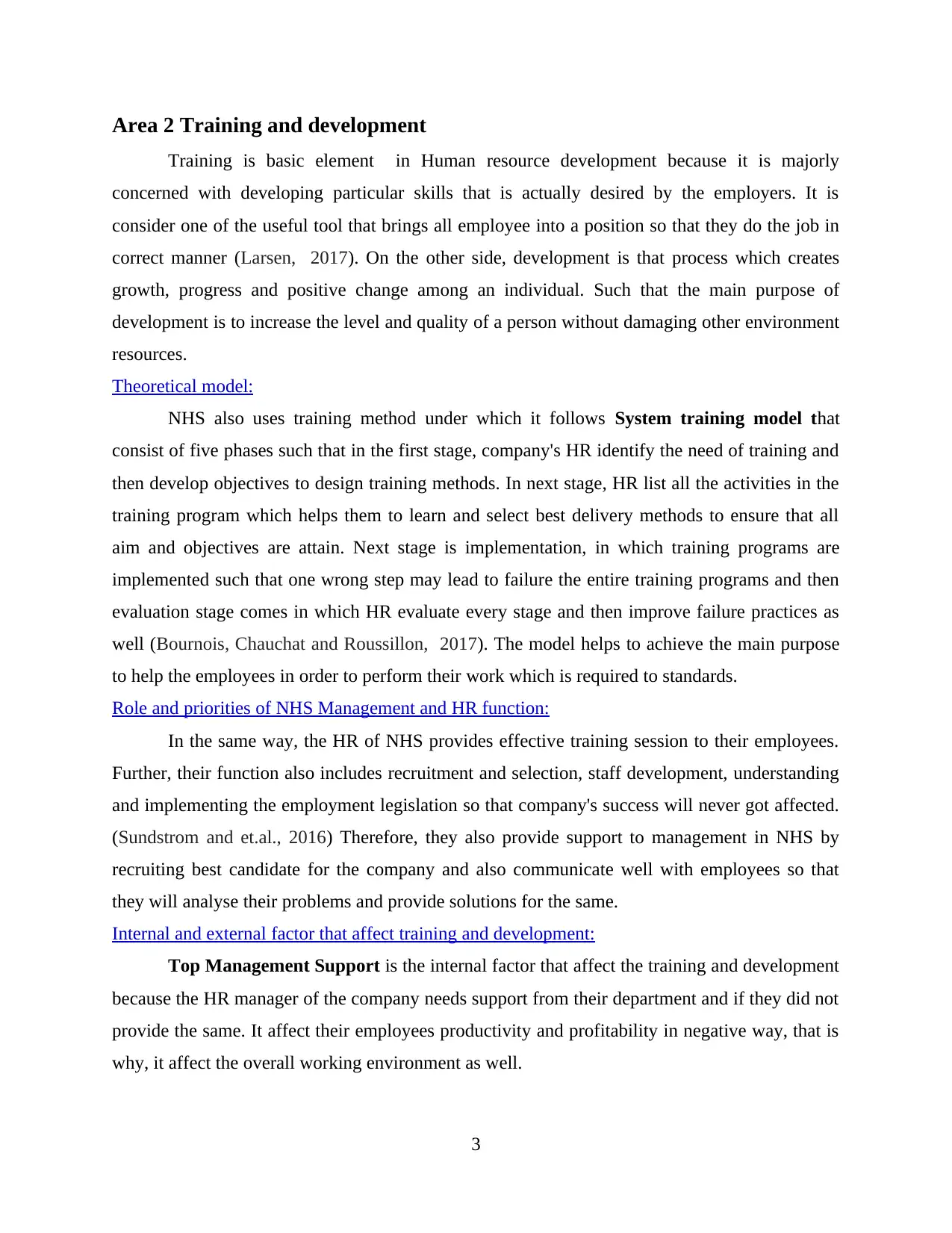
Area 2 Training and development
Training is basic element in Human resource development because it is majorly
concerned with developing particular skills that is actually desired by the employers. It is
consider one of the useful tool that brings all employee into a position so that they do the job in
correct manner (Larsen, 2017). On the other side, development is that process which creates
growth, progress and positive change among an individual. Such that the main purpose of
development is to increase the level and quality of a person without damaging other environment
resources.
Theoretical model:
NHS also uses training method under which it follows System training model that
consist of five phases such that in the first stage, company's HR identify the need of training and
then develop objectives to design training methods. In next stage, HR list all the activities in the
training program which helps them to learn and select best delivery methods to ensure that all
aim and objectives are attain. Next stage is implementation, in which training programs are
implemented such that one wrong step may lead to failure the entire training programs and then
evaluation stage comes in which HR evaluate every stage and then improve failure practices as
well (Bournois, Chauchat and Roussillon, 2017). The model helps to achieve the main purpose
to help the employees in order to perform their work which is required to standards.
Role and priorities of NHS Management and HR function:
In the same way, the HR of NHS provides effective training session to their employees.
Further, their function also includes recruitment and selection, staff development, understanding
and implementing the employment legislation so that company's success will never got affected.
(Sundstrom and et.al., 2016) Therefore, they also provide support to management in NHS by
recruiting best candidate for the company and also communicate well with employees so that
they will analyse their problems and provide solutions for the same.
Internal and external factor that affect training and development:
Top Management Support is the internal factor that affect the training and development
because the HR manager of the company needs support from their department and if they did not
provide the same. It affect their employees productivity and profitability in negative way, that is
why, it affect the overall working environment as well.
3
Training is basic element in Human resource development because it is majorly
concerned with developing particular skills that is actually desired by the employers. It is
consider one of the useful tool that brings all employee into a position so that they do the job in
correct manner (Larsen, 2017). On the other side, development is that process which creates
growth, progress and positive change among an individual. Such that the main purpose of
development is to increase the level and quality of a person without damaging other environment
resources.
Theoretical model:
NHS also uses training method under which it follows System training model that
consist of five phases such that in the first stage, company's HR identify the need of training and
then develop objectives to design training methods. In next stage, HR list all the activities in the
training program which helps them to learn and select best delivery methods to ensure that all
aim and objectives are attain. Next stage is implementation, in which training programs are
implemented such that one wrong step may lead to failure the entire training programs and then
evaluation stage comes in which HR evaluate every stage and then improve failure practices as
well (Bournois, Chauchat and Roussillon, 2017). The model helps to achieve the main purpose
to help the employees in order to perform their work which is required to standards.
Role and priorities of NHS Management and HR function:
In the same way, the HR of NHS provides effective training session to their employees.
Further, their function also includes recruitment and selection, staff development, understanding
and implementing the employment legislation so that company's success will never got affected.
(Sundstrom and et.al., 2016) Therefore, they also provide support to management in NHS by
recruiting best candidate for the company and also communicate well with employees so that
they will analyse their problems and provide solutions for the same.
Internal and external factor that affect training and development:
Top Management Support is the internal factor that affect the training and development
because the HR manager of the company needs support from their department and if they did not
provide the same. It affect their employees productivity and profitability in negative way, that is
why, it affect the overall working environment as well.
3
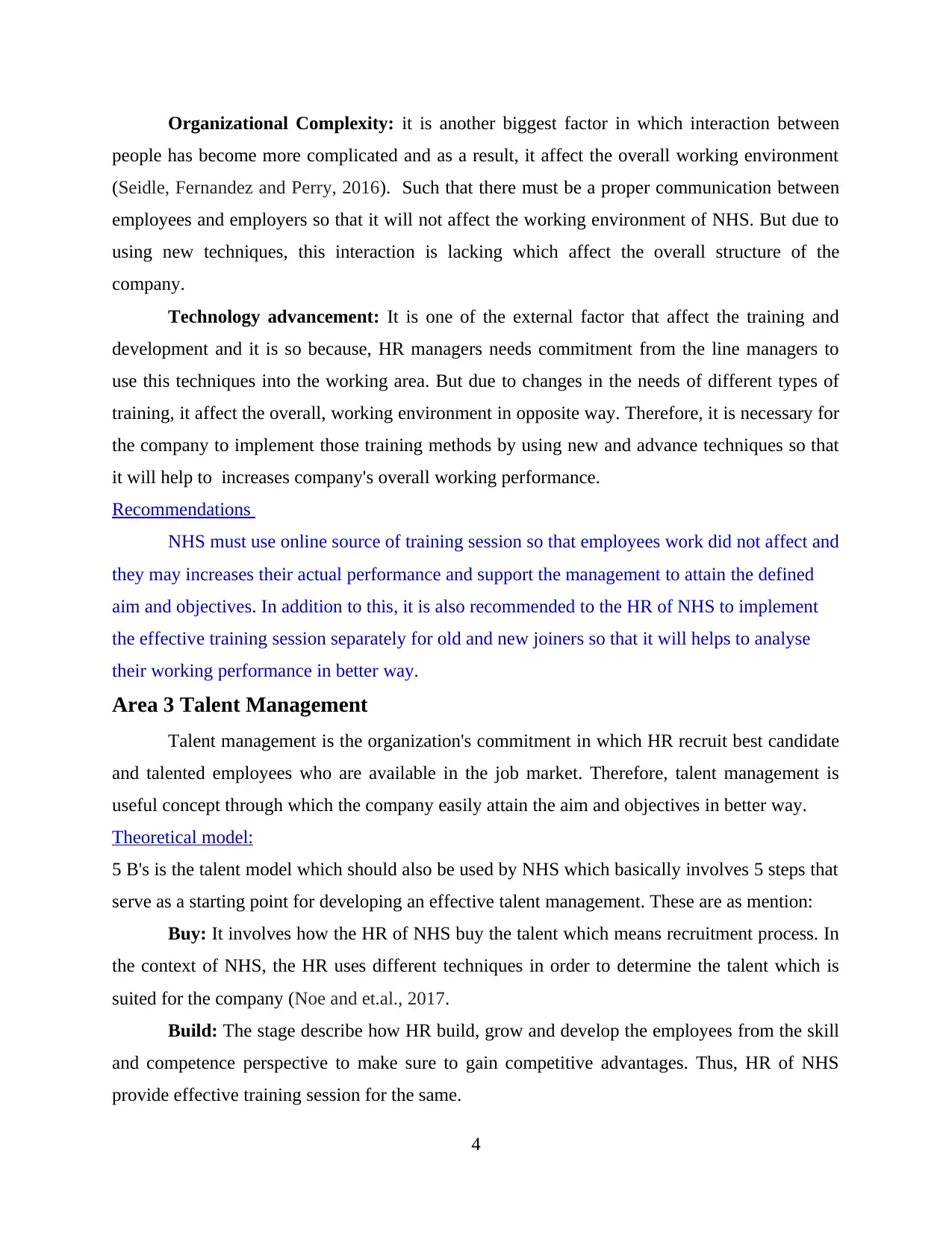
Organizational Complexity: it is another biggest factor in which interaction between
people has become more complicated and as a result, it affect the overall working environment
(Seidle, Fernandez and Perry, 2016). Such that there must be a proper communication between
employees and employers so that it will not affect the working environment of NHS. But due to
using new techniques, this interaction is lacking which affect the overall structure of the
company.
Technology advancement: It is one of the external factor that affect the training and
development and it is so because, HR managers needs commitment from the line managers to
use this techniques into the working area. But due to changes in the needs of different types of
training, it affect the overall, working environment in opposite way. Therefore, it is necessary for
the company to implement those training methods by using new and advance techniques so that
it will help to increases company's overall working performance.
Recommendations
NHS must use online source of training session so that employees work did not affect and
they may increases their actual performance and support the management to attain the defined
aim and objectives. In addition to this, it is also recommended to the HR of NHS to implement
the effective training session separately for old and new joiners so that it will helps to analyse
their working performance in better way.
Area 3 Talent Management
Talent management is the organization's commitment in which HR recruit best candidate
and talented employees who are available in the job market. Therefore, talent management is
useful concept through which the company easily attain the aim and objectives in better way.
Theoretical model:
5 B's is the talent model which should also be used by NHS which basically involves 5 steps that
serve as a starting point for developing an effective talent management. These are as mention:
Buy: It involves how the HR of NHS buy the talent which means recruitment process. In
the context of NHS, the HR uses different techniques in order to determine the talent which is
suited for the company (Noe and et.al., 2017.
Build: The stage describe how HR build, grow and develop the employees from the skill
and competence perspective to make sure to gain competitive advantages. Thus, HR of NHS
provide effective training session for the same.
4
people has become more complicated and as a result, it affect the overall working environment
(Seidle, Fernandez and Perry, 2016). Such that there must be a proper communication between
employees and employers so that it will not affect the working environment of NHS. But due to
using new techniques, this interaction is lacking which affect the overall structure of the
company.
Technology advancement: It is one of the external factor that affect the training and
development and it is so because, HR managers needs commitment from the line managers to
use this techniques into the working area. But due to changes in the needs of different types of
training, it affect the overall, working environment in opposite way. Therefore, it is necessary for
the company to implement those training methods by using new and advance techniques so that
it will help to increases company's overall working performance.
Recommendations
NHS must use online source of training session so that employees work did not affect and
they may increases their actual performance and support the management to attain the defined
aim and objectives. In addition to this, it is also recommended to the HR of NHS to implement
the effective training session separately for old and new joiners so that it will helps to analyse
their working performance in better way.
Area 3 Talent Management
Talent management is the organization's commitment in which HR recruit best candidate
and talented employees who are available in the job market. Therefore, talent management is
useful concept through which the company easily attain the aim and objectives in better way.
Theoretical model:
5 B's is the talent model which should also be used by NHS which basically involves 5 steps that
serve as a starting point for developing an effective talent management. These are as mention:
Buy: It involves how the HR of NHS buy the talent which means recruitment process. In
the context of NHS, the HR uses different techniques in order to determine the talent which is
suited for the company (Noe and et.al., 2017.
Build: The stage describe how HR build, grow and develop the employees from the skill
and competence perspective to make sure to gain competitive advantages. Thus, HR of NHS
provide effective training session for the same.
4
⊘ This is a preview!⊘
Do you want full access?
Subscribe today to unlock all pages.

Trusted by 1+ million students worldwide
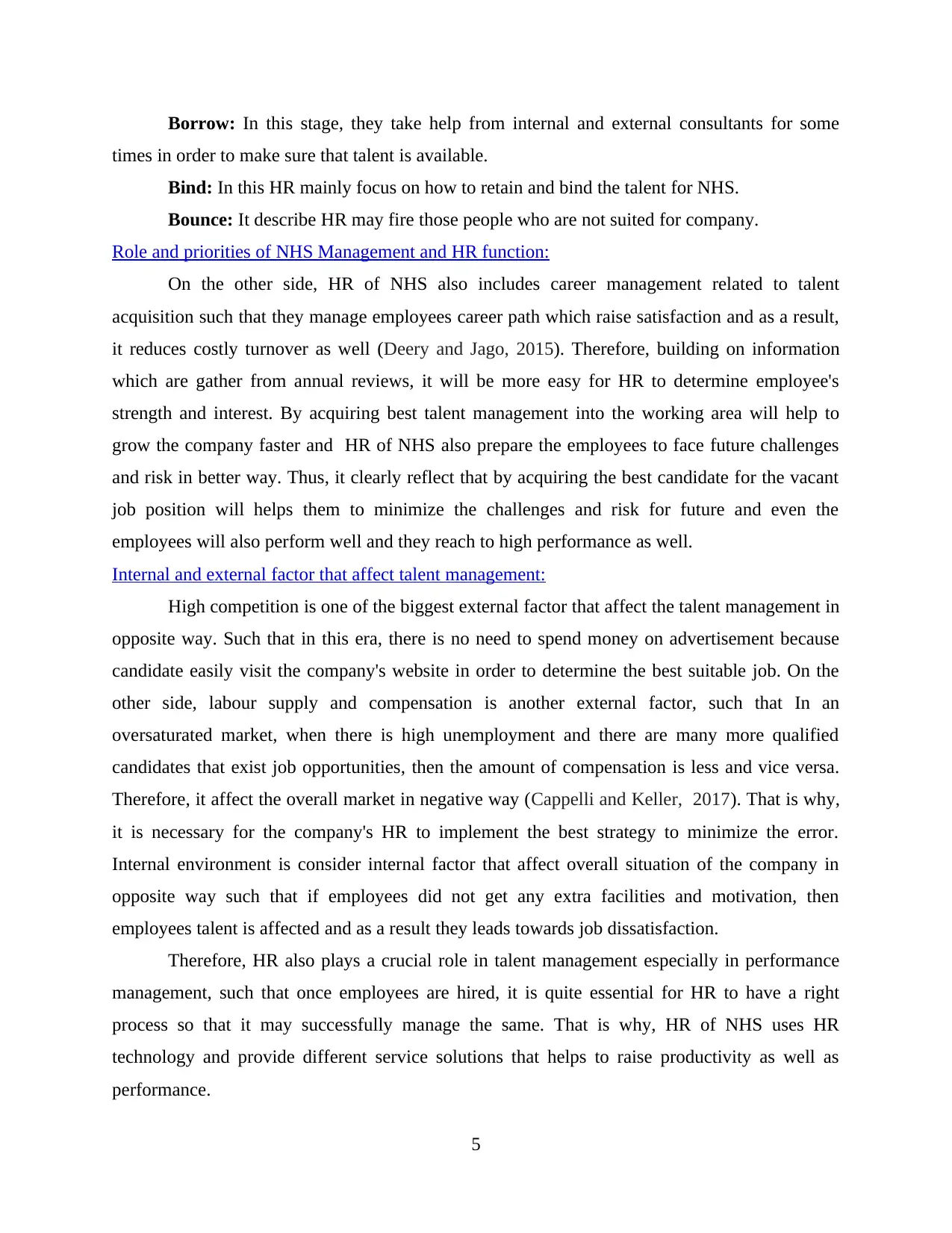
Borrow: In this stage, they take help from internal and external consultants for some
times in order to make sure that talent is available.
Bind: In this HR mainly focus on how to retain and bind the talent for NHS.
Bounce: It describe HR may fire those people who are not suited for company.
Role and priorities of NHS Management and HR function:
On the other side, HR of NHS also includes career management related to talent
acquisition such that they manage employees career path which raise satisfaction and as a result,
it reduces costly turnover as well (Deery and Jago, 2015). Therefore, building on information
which are gather from annual reviews, it will be more easy for HR to determine employee's
strength and interest. By acquiring best talent management into the working area will help to
grow the company faster and HR of NHS also prepare the employees to face future challenges
and risk in better way. Thus, it clearly reflect that by acquiring the best candidate for the vacant
job position will helps them to minimize the challenges and risk for future and even the
employees will also perform well and they reach to high performance as well.
Internal and external factor that affect talent management:
High competition is one of the biggest external factor that affect the talent management in
opposite way. Such that in this era, there is no need to spend money on advertisement because
candidate easily visit the company's website in order to determine the best suitable job. On the
other side, labour supply and compensation is another external factor, such that In an
oversaturated market, when there is high unemployment and there are many more qualified
candidates that exist job opportunities, then the amount of compensation is less and vice versa.
Therefore, it affect the overall market in negative way (Cappelli and Keller, 2017). That is why,
it is necessary for the company's HR to implement the best strategy to minimize the error.
Internal environment is consider internal factor that affect overall situation of the company in
opposite way such that if employees did not get any extra facilities and motivation, then
employees talent is affected and as a result they leads towards job dissatisfaction.
Therefore, HR also plays a crucial role in talent management especially in performance
management, such that once employees are hired, it is quite essential for HR to have a right
process so that it may successfully manage the same. That is why, HR of NHS uses HR
technology and provide different service solutions that helps to raise productivity as well as
performance.
5
times in order to make sure that talent is available.
Bind: In this HR mainly focus on how to retain and bind the talent for NHS.
Bounce: It describe HR may fire those people who are not suited for company.
Role and priorities of NHS Management and HR function:
On the other side, HR of NHS also includes career management related to talent
acquisition such that they manage employees career path which raise satisfaction and as a result,
it reduces costly turnover as well (Deery and Jago, 2015). Therefore, building on information
which are gather from annual reviews, it will be more easy for HR to determine employee's
strength and interest. By acquiring best talent management into the working area will help to
grow the company faster and HR of NHS also prepare the employees to face future challenges
and risk in better way. Thus, it clearly reflect that by acquiring the best candidate for the vacant
job position will helps them to minimize the challenges and risk for future and even the
employees will also perform well and they reach to high performance as well.
Internal and external factor that affect talent management:
High competition is one of the biggest external factor that affect the talent management in
opposite way. Such that in this era, there is no need to spend money on advertisement because
candidate easily visit the company's website in order to determine the best suitable job. On the
other side, labour supply and compensation is another external factor, such that In an
oversaturated market, when there is high unemployment and there are many more qualified
candidates that exist job opportunities, then the amount of compensation is less and vice versa.
Therefore, it affect the overall market in negative way (Cappelli and Keller, 2017). That is why,
it is necessary for the company's HR to implement the best strategy to minimize the error.
Internal environment is consider internal factor that affect overall situation of the company in
opposite way such that if employees did not get any extra facilities and motivation, then
employees talent is affected and as a result they leads towards job dissatisfaction.
Therefore, HR also plays a crucial role in talent management especially in performance
management, such that once employees are hired, it is quite essential for HR to have a right
process so that it may successfully manage the same. That is why, HR of NHS uses HR
technology and provide different service solutions that helps to raise productivity as well as
performance.
5
Paraphrase This Document
Need a fresh take? Get an instant paraphrase of this document with our AI Paraphraser
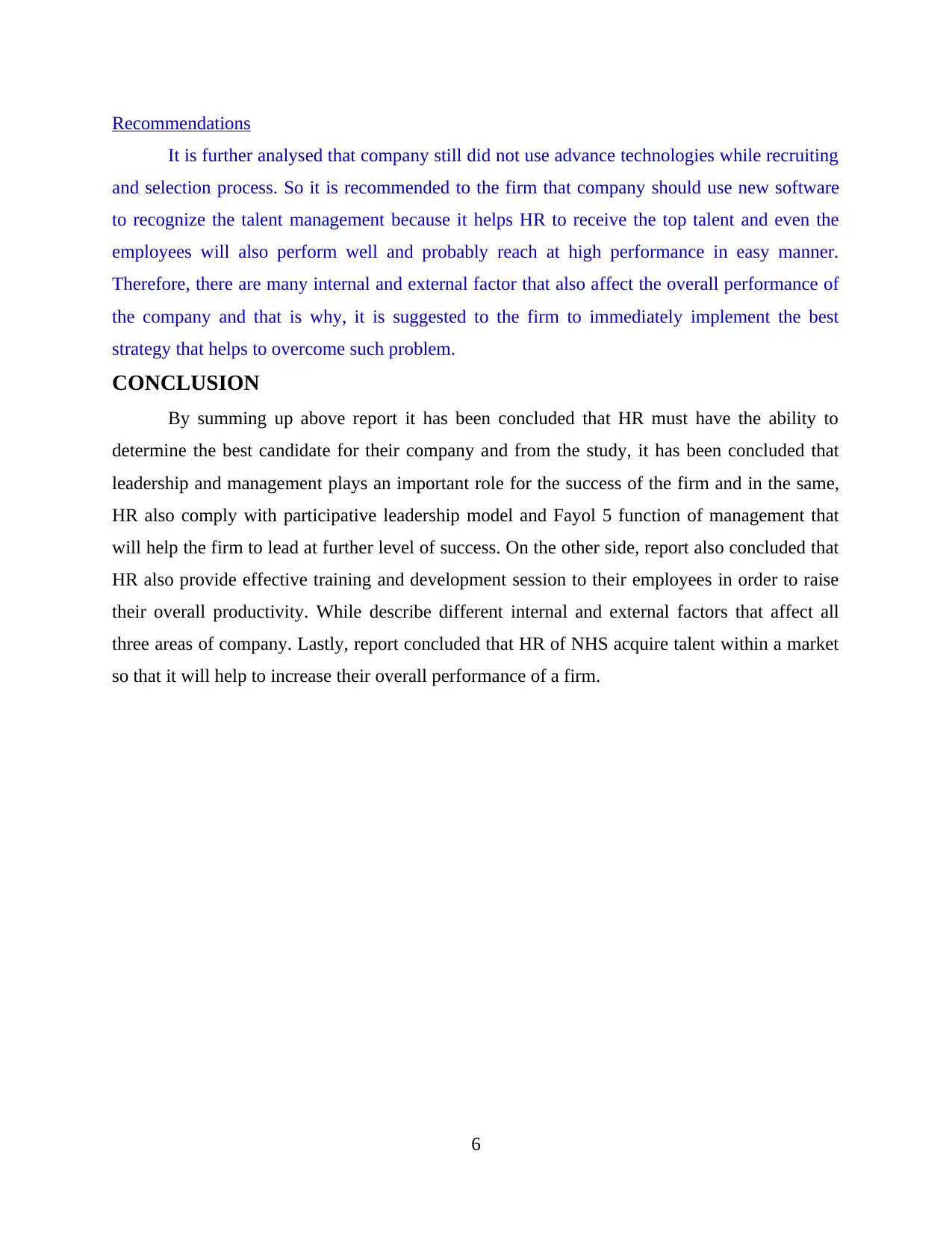
Recommendations
It is further analysed that company still did not use advance technologies while recruiting
and selection process. So it is recommended to the firm that company should use new software
to recognize the talent management because it helps HR to receive the top talent and even the
employees will also perform well and probably reach at high performance in easy manner.
Therefore, there are many internal and external factor that also affect the overall performance of
the company and that is why, it is suggested to the firm to immediately implement the best
strategy that helps to overcome such problem.
CONCLUSION
By summing up above report it has been concluded that HR must have the ability to
determine the best candidate for their company and from the study, it has been concluded that
leadership and management plays an important role for the success of the firm and in the same,
HR also comply with participative leadership model and Fayol 5 function of management that
will help the firm to lead at further level of success. On the other side, report also concluded that
HR also provide effective training and development session to their employees in order to raise
their overall productivity. While describe different internal and external factors that affect all
three areas of company. Lastly, report concluded that HR of NHS acquire talent within a market
so that it will help to increase their overall performance of a firm.
6
It is further analysed that company still did not use advance technologies while recruiting
and selection process. So it is recommended to the firm that company should use new software
to recognize the talent management because it helps HR to receive the top talent and even the
employees will also perform well and probably reach at high performance in easy manner.
Therefore, there are many internal and external factor that also affect the overall performance of
the company and that is why, it is suggested to the firm to immediately implement the best
strategy that helps to overcome such problem.
CONCLUSION
By summing up above report it has been concluded that HR must have the ability to
determine the best candidate for their company and from the study, it has been concluded that
leadership and management plays an important role for the success of the firm and in the same,
HR also comply with participative leadership model and Fayol 5 function of management that
will help the firm to lead at further level of success. On the other side, report also concluded that
HR also provide effective training and development session to their employees in order to raise
their overall productivity. While describe different internal and external factors that affect all
three areas of company. Lastly, report concluded that HR of NHS acquire talent within a market
so that it will help to increase their overall performance of a firm.
6
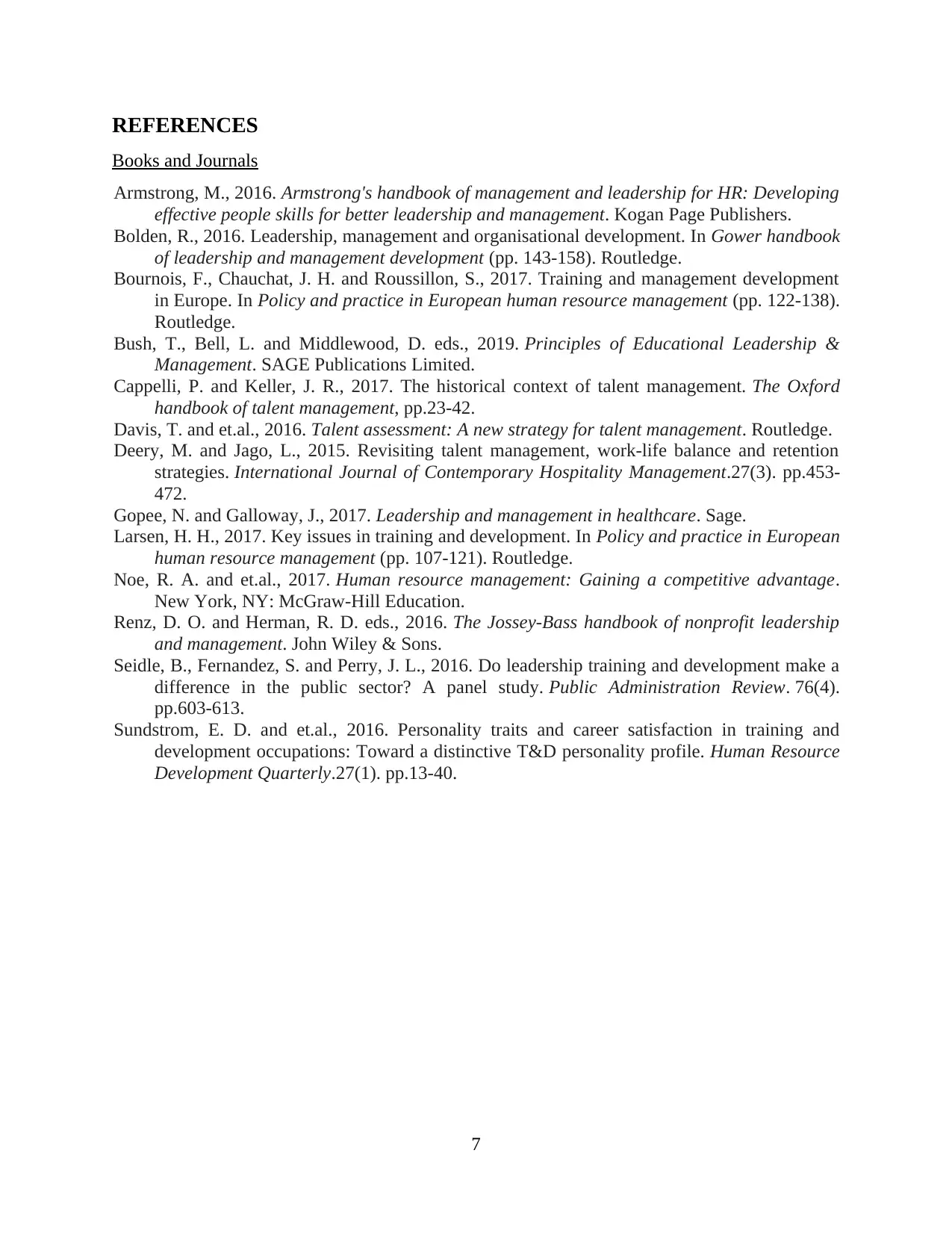
REFERENCES
Books and Journals
Armstrong, M., 2016. Armstrong's handbook of management and leadership for HR: Developing
effective people skills for better leadership and management. Kogan Page Publishers.
Bolden, R., 2016. Leadership, management and organisational development. In Gower handbook
of leadership and management development (pp. 143-158). Routledge.
Bournois, F., Chauchat, J. H. and Roussillon, S., 2017. Training and management development
in Europe. In Policy and practice in European human resource management (pp. 122-138).
Routledge.
Bush, T., Bell, L. and Middlewood, D. eds., 2019. Principles of Educational Leadership &
Management. SAGE Publications Limited.
Cappelli, P. and Keller, J. R., 2017. The historical context of talent management. The Oxford
handbook of talent management, pp.23-42.
Davis, T. and et.al., 2016. Talent assessment: A new strategy for talent management. Routledge.
Deery, M. and Jago, L., 2015. Revisiting talent management, work-life balance and retention
strategies. International Journal of Contemporary Hospitality Management.27(3). pp.453-
472.
Gopee, N. and Galloway, J., 2017. Leadership and management in healthcare. Sage.
Larsen, H. H., 2017. Key issues in training and development. In Policy and practice in European
human resource management (pp. 107-121). Routledge.
Noe, R. A. and et.al., 2017. Human resource management: Gaining a competitive advantage.
New York, NY: McGraw-Hill Education.
Renz, D. O. and Herman, R. D. eds., 2016. The Jossey-Bass handbook of nonprofit leadership
and management. John Wiley & Sons.
Seidle, B., Fernandez, S. and Perry, J. L., 2016. Do leadership training and development make a
difference in the public sector? A panel study. Public Administration Review. 76(4).
pp.603-613.
Sundstrom, E. D. and et.al., 2016. Personality traits and career satisfaction in training and
development occupations: Toward a distinctive T&D personality profile. Human Resource
Development Quarterly.27(1). pp.13-40.
7
Books and Journals
Armstrong, M., 2016. Armstrong's handbook of management and leadership for HR: Developing
effective people skills for better leadership and management. Kogan Page Publishers.
Bolden, R., 2016. Leadership, management and organisational development. In Gower handbook
of leadership and management development (pp. 143-158). Routledge.
Bournois, F., Chauchat, J. H. and Roussillon, S., 2017. Training and management development
in Europe. In Policy and practice in European human resource management (pp. 122-138).
Routledge.
Bush, T., Bell, L. and Middlewood, D. eds., 2019. Principles of Educational Leadership &
Management. SAGE Publications Limited.
Cappelli, P. and Keller, J. R., 2017. The historical context of talent management. The Oxford
handbook of talent management, pp.23-42.
Davis, T. and et.al., 2016. Talent assessment: A new strategy for talent management. Routledge.
Deery, M. and Jago, L., 2015. Revisiting talent management, work-life balance and retention
strategies. International Journal of Contemporary Hospitality Management.27(3). pp.453-
472.
Gopee, N. and Galloway, J., 2017. Leadership and management in healthcare. Sage.
Larsen, H. H., 2017. Key issues in training and development. In Policy and practice in European
human resource management (pp. 107-121). Routledge.
Noe, R. A. and et.al., 2017. Human resource management: Gaining a competitive advantage.
New York, NY: McGraw-Hill Education.
Renz, D. O. and Herman, R. D. eds., 2016. The Jossey-Bass handbook of nonprofit leadership
and management. John Wiley & Sons.
Seidle, B., Fernandez, S. and Perry, J. L., 2016. Do leadership training and development make a
difference in the public sector? A panel study. Public Administration Review. 76(4).
pp.603-613.
Sundstrom, E. D. and et.al., 2016. Personality traits and career satisfaction in training and
development occupations: Toward a distinctive T&D personality profile. Human Resource
Development Quarterly.27(1). pp.13-40.
7
⊘ This is a preview!⊘
Do you want full access?
Subscribe today to unlock all pages.

Trusted by 1+ million students worldwide
1 out of 9
Related Documents
Your All-in-One AI-Powered Toolkit for Academic Success.
+13062052269
info@desklib.com
Available 24*7 on WhatsApp / Email
![[object Object]](/_next/static/media/star-bottom.7253800d.svg)
Unlock your academic potential
Copyright © 2020–2025 A2Z Services. All Rights Reserved. Developed and managed by ZUCOL.





